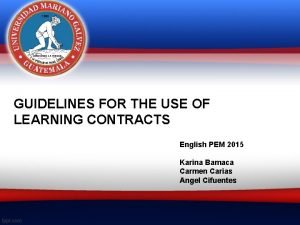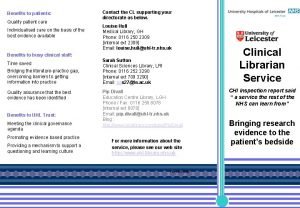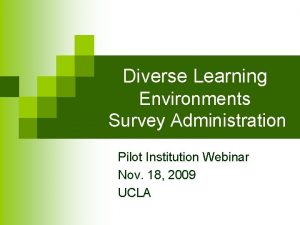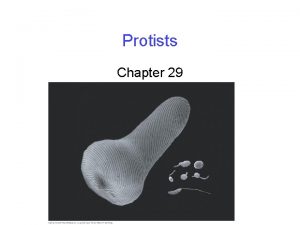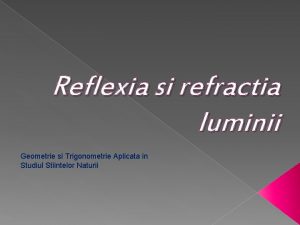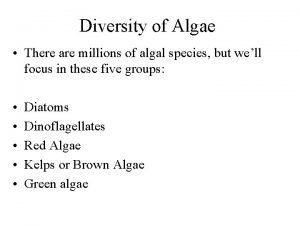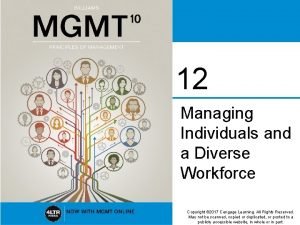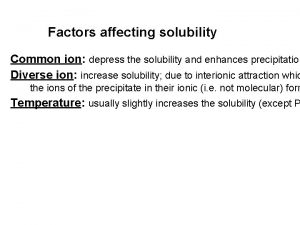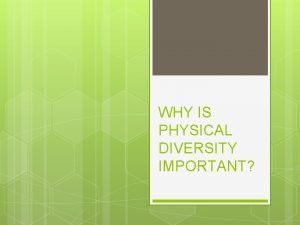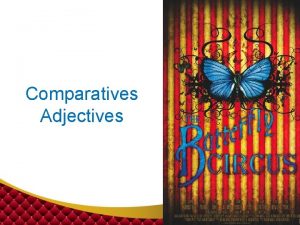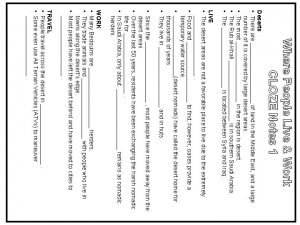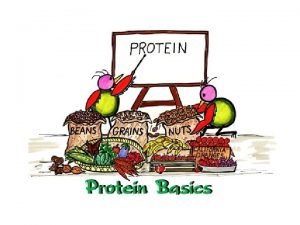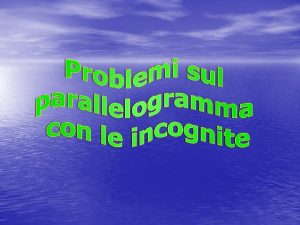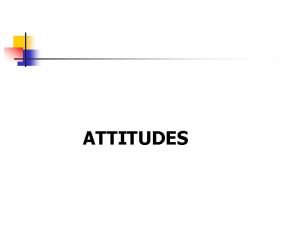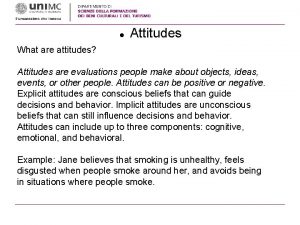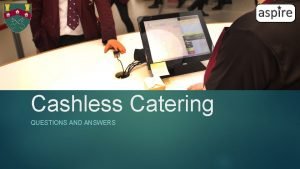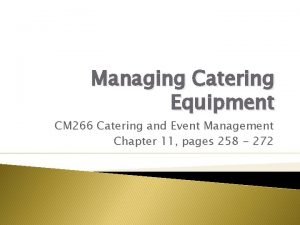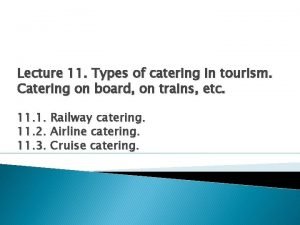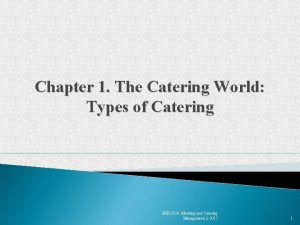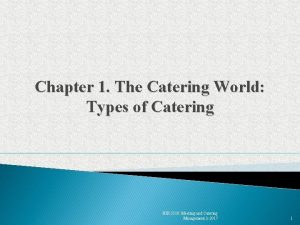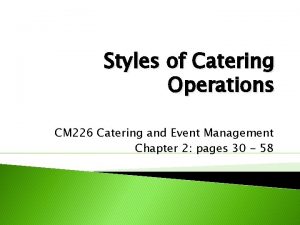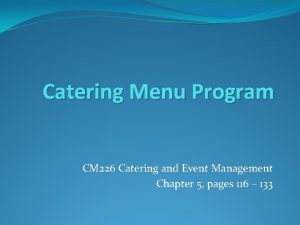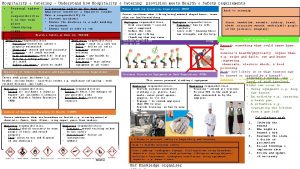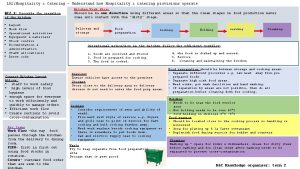CATERING FOR DIVERSE NEEDS Individualised Planning Attitudes Awareness




























- Slides: 28

CATERING FOR DIVERSE NEEDS Individualised Planning Attitudes Awareness Legislation Policy Paula Power Coordinator Students with Disability Team CEWA School Support Services Equipment Resources Community Parents Peers

WHAT ARE WE AIMING FOR? • An inclusive school …. . one which acknowledges and demonstrates its acceptance of diversity within the school community. • It is measured by the degree to which each and every student is catered for and achieves success

INCLUSIVITY MEANS ENSURING ALL GROUPS OF STUDENTS ARE INCLUDED AND VALUED • Organise teaching and learning opportunities so that each student has a learning experience that “fits”

MANDATE OF THE CATHOLIC EDUCATION COMMISSION OF WA 2009 -2015 q Mandate Letter Extract (21) …The values of the Gospel lead to genuine peace and harmony. They make easier the promotions of reconciliation, justice, compassion and mercy, as well as special commitment to the poor, the disabled and to all with special needs

ST FRANCIS XAVIER PRIMARY SCHOOL VISION STATEMENT We are called to provide an exemplary Catholic Education • Discipleship: With Christ as our light we aspire to nurture the whole person in a community centred on Gospel values. • Learning: We are committed to providing an education that empowers all to become life-long learners.

DISABILITY STANDARDS FOR EDUCATION 2005

INTENT OF STANDARDS q Outlines the rights of students with a disability and students with learning difficulties in the area of education and training. q Clarify and make explicit the obligations of education and training providers All students (including students with disabilities) should be treated with dignity and enjoy the benefits of education and training in a supportive environment which values and encourages participation by all students.

DISABILITY STANDARDS FOR EDUCATION Part 4 -8 of the Standards specify how education & training are to be made accessible to students with disabilities. They cover the following areas §enrolment §participation §curriculum development, accreditation & delivery §student support services §elimination of harassment & victimisation

Standards for Enrolment Measures for compliance • Need to ensure that the same enrolment process applies to all prospective students • Information about the enrolment process is clear & accessible to all • Enrolment applications are made available in a range of formats & designed so that they are easily completed • Information about entry requirements enables the student, or associates to make informed choices

PART 6 STANDARDS FOR CURRICULUM DEVELOPMENT, ACCREDITATION & DELIVERY Measures for Compliance • The curriculum, teaching materials, assessment requirements are accessible & appropriate to the needs of the student. • Delivery modes & learning activities take account of intended educational outcomes, learning capacity & needs of the student. • Study materials made available in an appropriate format in a timely manner. • Teaching & delivery strategies are adjusted. • All activities designed to include the student – excursions. • Assessment procedures appropriately adapted.

STANDARDS FOR PARTICIPATION MEASURES FOR COMPLIANCE • Course or program activities must include activities in which all students are able to participate • Appropriate programs negotiated, agreed & then implemented • Additional support must be provided where required • Where a student cannot participate, the student must be offered a reasonable substitute • All activities-within & external to the classroom must be designed to include all students

WHICH STUDENTS ARE WE TALKING ABOUT? DSE standards apply for Students who have ü Physical impairment ü Sensory impairment ü Intellectual disability ü Brain injury, through accident or illness ü Neurological/psychiatric including depression, anxiety, ODD, conduct disorders, ADHD ü Autism Spectrum Disorder ü Language disorders q Learning disabilities such as dyslexia, dysgraphia q Learning difficulties

CATHOLIC SCHOOLS IN WESTERN AUSTRALIA PRIMARY DISABLING CONDITIONS 2005 -2016 2005 2016 Autism Spectrum Disorders 242 780 Intellectual Disabilities 621 447 Physical Disabilities 219 544 Psychiatric/Social-Emotional disorders 28 160 Language Disorders 67 127 Sensory Impairment Hearing/Vision 115 217 1292 2275

NATIONALLY CONSISTENT COLLECTION OF DATA SCHOOL STUDENTS WITH DISABILITY • • Four Disability Categories Cognitive Physical Sensory Social Emotional • • Four Levels of Adjustments Support provided within quality differentiated teaching practice Supplementary Substantial Extensive Standing Council on School Education and Early Childhood - 2013 “ …model relies on the informed judgement of school principals, teachers and other school staff about which students in their school are being provided with adjustments based on disability as defined by the DDA”

IMPLICATIONS OF THE DSE DEFINITION OF DISABILITY Students with disability eligible for consideration under CEWA School Support Program Students identified under the DSE as having special educational needs (NCCD) 2 -3% of population Up to 19% of the population 2275 students Could be up to 13, 000 students in Catholic schools in WA Must have an Individualised Learning Plan (I. E. P, C. A. P, Health Care Plan…) May need an individualised learning plan (I. E. P, C. A. P, PLP, Health Care Plan…)

INDIVIDUAL EDUCATION PLANNING PROCESS Individualised Planning • • is a collaborative , consultative process is a way of planning to meet the individual needs of students establishes goals & objectives a documented statement of skills, knowledge & tasks Individual Education Plan (I. E. P) Articulate significant teaching and learning adjustments that affect most learning areas – ongoing Curriculum Adjustment Plan (C. A. P) Articulate “Instructional” and “Environmental” adjustments required for a student to access the curriculum

WHO DECIDES ? • Based on student’s level of need. • Determined by the level of adjustment required. • Some students who are not eligible for the targeted CEWA Students with Disability School Support Program, may require an I. E. P rather than a C. A. P to articulate their educational needs. • Is developed as a result of the collaborative efforts of principal, class teacher, school learning support team, parents, CEWA SWD consultant.

INDIVIDUAL EDUCATION PLAN (I. E. P) • An I. E. P articulates significant teaching and learning adjustments and modifications that affect most learning areas. • Students will have modified goals and specific objectives that differ from those of peers. • In general the student will be learning different things from the rest of the class.

INDIVIDUAL EDUCATION PLAN • Identifies student’s level of skill • Identifies broad directions of development – (Goals) • Identifies what the student is expected to learn (Objectives) • How it will be taught? – (Strategies) • How it will be monitored and assessed? – (Evaluation) • Who will do the teaching? • Reports on meetings, records other supports….

GOALS • Generated from collated information about the student. • IEP goals should enable the child to learn the basic skills that are necessary for the child to be independent and self-sufficient. Goals should include academic and functional areas if needed ⁻ ⁻ ⁻ ⁻ Speech/Communication Independence Independent Living Skills Social Skills Information and Communications Technology Behaviour Functional Literacy Functional Numeracy

OBJECTIVES

ABLEWA: ABILITY BASED LEARNING EDUCATION WA • The ABLEWA assessment tools for students with disability and additional learning needs are made up of four assessments that are completed online. • English, Speaking and Listening – the development of functional communication skills leading towards recognition and use of the social conventions of communication • English, Reading and Writing – the development of the use and interpretation of symbolic forms of representation leading towards early reading and writing • Interpersonal Development – the development of skills to support social interaction, social responsibility, and a capacity to transcend social difficulties • Personal Learning – the development of basic skills related to attention, memory, and becoming an independent learner.

CURRICULUM ADJUSTMENT PLAN (C. A. P) • In general the student on a C. A. P will be learning within a broad framework with the rest of the class. • Teachers use their knowledge of students’ learning and support needs to make instructional and environmental adjustments to ensure a student can access the curriculum. • Students who, with adjustments by the teacher, will achieve the same or close to the same outcomes as peers.

Adjustments INSTRUCTION concrete materials simplified language modified text use of assistive technology, such as: voice output communication aid (VOCA) • alternative formats, such as: • Braille or large print • oral/sign interpreters • subtitled videos • Alternative opportunities to present learning • • ENVIRONMENT • provide physical access to the teaching and learning environment • provide peer assistance • provide access to alternative equipment and furnishings • use support personnel • changes to buildings and classrooms Adjustments can make the difference between a child merely being present in the class and a child being actively involved

Educational Planning to meet Individual Student’s Needs Collating Information Evaluation & Reporting Stakeholders Evaluating Student Needs/ Assessments Comments COLLABORATION Monitoring A Continuous Process Goals & Objectives Assessment Independence Level Reviews Meetings Prioritising/Setting Implementation Strategies/Resources Who/How/When

Monitoring A C D Achieved Continuing Deferred Monitoring Assessment Independence Level Reviews Term 1 Term 2 Term 3 Term 4 Collate Information Implement Revise IEP /CAP Implement Develop IEP /CAP Monitor Implement Evaluate Monitor Report þ Monitoring is a continual and collaborative review process. þ Progress towards the achievement of the goals and objectives as stated in the IEP /CAP, is monitored through ongoing assessment of student’s work. þ The information collected is used as the basis for reviewing whether or not the instructional program has produced the desired results and plans are made for further improvement. þ In monitoring student progress the level of independence also needs to be recorded - noting the level of prompting required.

A C D Achieved Continuing Deferred Evaluation & Reporting Comments Progress Maps Evaluation: • A comprehensive evaluation of the IEP occurs when monitored Goals and Objectives are reviewed. • Review each objective and indicate in the Evaluation Comment column on the IEP A - achievement of an objective, C - continuation of the objective or D - to identify the need to defer the objective. • Through ongoing assessment of student’s work, progress is monitored and plans are made for further improvement. Reporting: • Students with disability that have significant adjustments articulated in an IEP will have progress reported against the learning outcomes articulated in the IEP not using A-E grades. • Students with learning needs who have a C. A. P in one or more learning areas will have their progress reported against their year level descriptor by using A-E grades.

SEQTA : INDIVIDUALISED PLANS
 Diversity of protists
Diversity of protists Individualised education
Individualised education Individualised patient care
Individualised patient care Cvs privacy awareness training answers
Cvs privacy awareness training answers Strategic gender needs and practical gender needs
Strategic gender needs and practical gender needs Primary needs and secondary needs
Primary needs and secondary needs Learning situation analysis
Learning situation analysis Satisfaction
Satisfaction Primary needs and secondary needs
Primary needs and secondary needs Individuals and families diverse perspectives
Individuals and families diverse perspectives Diverse learning environments survey
Diverse learning environments survey The most diverse of the four eukaryotic kingdoms is the
The most diverse of the four eukaryotic kingdoms is the La trecerea luminii dintr-un mediu transparent in altul
La trecerea luminii dintr-un mediu transparent in altul Chapter 16 section 1 russia and the western republics
Chapter 16 section 1 russia and the western republics Algal
Algal What is deep level diversity
What is deep level diversity Diverse ion effect
Diverse ion effect Physical diversity definition
Physical diversity definition Sexual reproduction
Sexual reproduction Art is diverse
Art is diverse Diverse societies in africa
Diverse societies in africa Chrysophyta
Chrysophyta Biological disturbance
Biological disturbance One syllable adjectives
One syllable adjectives African iron age
African iron age Cloze maker
Cloze maker Introduction for ict
Introduction for ict Most diverse biomolecules
Most diverse biomolecules Quante altezze ha un triangolo
Quante altezze ha un triangolo

